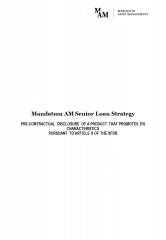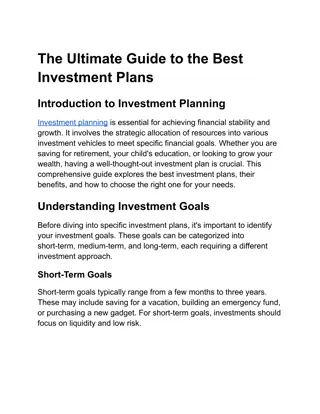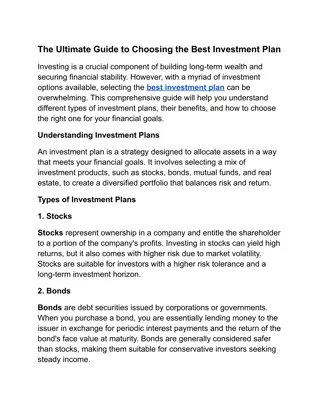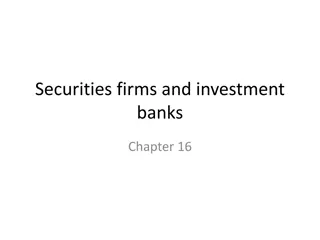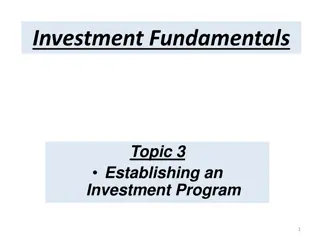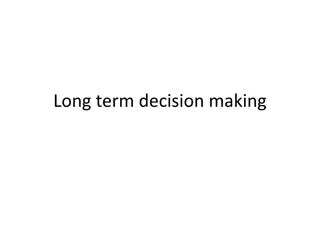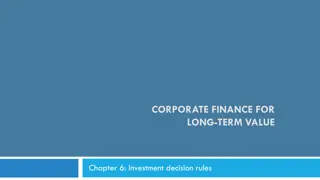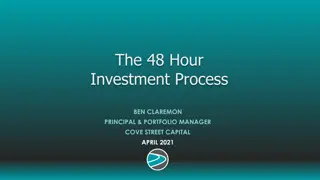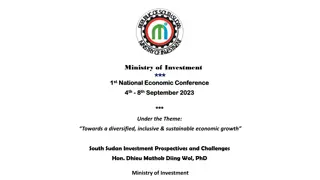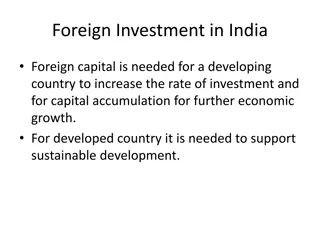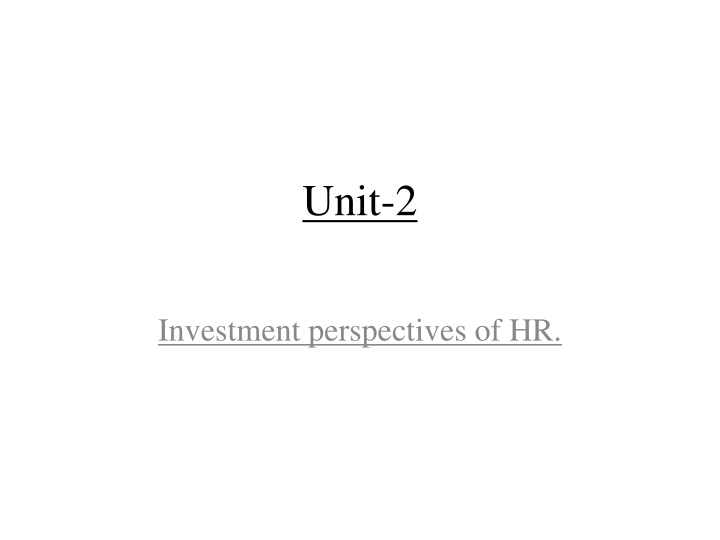
Investment Perspectives of HR: Maximizing Human Resources for Competitive Advantage
Investing in human resources is crucial for organizational success and competitive advantage. This article explores the importance of training, development, and strategic HR investment decisions to enhance employee skills and drive organizational growth.
Download Presentation

Please find below an Image/Link to download the presentation.
The content on the website is provided AS IS for your information and personal use only. It may not be sold, licensed, or shared on other websites without obtaining consent from the author. If you encounter any issues during the download, it is possible that the publisher has removed the file from their server.
You are allowed to download the files provided on this website for personal or commercial use, subject to the condition that they are used lawfully. All files are the property of their respective owners.
The content on the website is provided AS IS for your information and personal use only. It may not be sold, licensed, or shared on other websites without obtaining consent from the author.
E N D
Presentation Transcript
Unit-2 Investment perspectives of HR.
Introduction A Focus solely on investment in physical resources as opposed to human resources is short sighted. Strategies have found that having superior production facilities or a superior product are usually not enough to sustain an advantage over competitors. There is little doubt that organisations will need to invest heavily in the human resources in order to be competitive.
Meaning of investment perspectives of HR Investment in human resources is a strategy and many organisations indicate that employees are viewed as valuable Investments. Investment in human resources takes the following forms like training, development, retention management, career planning ,job design options etc.
Factors relevant to strategy based human resource investment decisions Managerial values Risk and return on investment economic rationale for investment in training Investment analysis Outsourcing as an alternative to investments in HR management development prevention of skill obsolescence reductions in career plateauing economic rationale for investment in training availability of outsourcing
I) Training Introduction after an employee is selected, placed and introduced he or she must be provided with training facilities. Meaning Training is the act of increasing the knowledge and skill of an employee for doing a particular job. in other words training is a short-term educational process and utilising a systematic and organised procedure by which employees learn technical knowledge and skills for a definite purpose. Importance of training 1) To develop employees 2) organisational requirements 3) Assets of the organisation 4) organisational efficiency, productivity and development 5) organisational growth
Benefits of training [need for training] 1)Higher productivity 2) better quality of work 3)self-confidence 4) cost reduction 5)safety 6)High moral 7) organisational climate 8) helps in matching employee specifications with job requirements and organisational needs 9)to overcome obsolescence
Training before employment Introduction Universities and colleges provide theoretical conceptual and principles based input that may not exactly fit the work environment when the student turns to employment. Internship and job shadowing try to provide practical knowledge. Internship Internship is one of the on the job training methods the before employment. Individuals entering industry in skilled trades like machinist, Electrician and laboratory technician, chartered accountant, MBBS management students etc are provided with in-depth instructions through theoretical and practical aspects. Internship benefits students Practical knowledge and exposure higher initial salaries faster promotions Job shadowing Job shadowing is defined as a work experience program where the students take up a job of a regular employee in full or part for a short duration with a view to gain practical knowledge and skills but not for a regular salary. Students during this program also observe the regular employees while discharging their responsibilities.
Need for job shadowing Acquisition of practical skill and behaviour by students understanding of organisations work environment and Culture by students evaluation of career option by students helps in inculcating latest curriculum by educational institutions use of job shadowing as a recruitment tool. Job shadowing tips Companies and job shadowed employees share the following information with the students. 1) History of the company products and Markets Here the company will tell the students how the company evolved, what was the company in the past present and future etc. 1) Roles and responsibilities 2) Personal attributes 3) career ladder 4) education requirements and opportunity 5) related jobs and careers
Steps in training I) Organisational analysis Organisation is studied in terms of objectives, resources, allocation and utilisation of growth potential environment etc. It is done to determine where training is required. Organisational analysis consists of the following Analysis of objectives resource utilisation analysis organisational climate analysis environmental scanning II) Task or role analysis It is a systematic and detailed analysis of jobs to identify job contents, the knowledge, skills and the aptitude required and the work behaviour. III) Manpower analysis In this analysis the person to be trained and the changes required in the knowledge, skills and attitudes of an employer determined.
IV) Designing a training program In order to achieve the training objectives and have appropriate training policy. A training policy represents the commitment of top management. The training program should focus on the following Responsibility of training selecting and motivating the target group preparing the trainers developing training package presentation performance tryout follow up
V) Conducting the training VI) Follow up evaluation Evaluation criteria Learning Behaviour Results
1) Methods of training [training methods and techniques] I) Induction training II) on the job training methods There are different on the job training methods Job rotation coaching job instruction internship apprentice ship
III) Off the job training methods Vestibule training role playing incident method in basket method management games sensitivity training lectures conferences managerial grid simulation behaviour modelling transaction analysis case study
II) Management development Management development focuses on developing managers and potential managers to acquire managerial skills and knowledge for decision-making, acquiring conceptual and interpersonal skills. Objectives 1. To improve performance of managers 2. to identify persons and prepare them for senior positions 3. to improve the morale of the members of the management group 4. to stimulate Creative Thinking 5. to stimulate analytical ability 6. to keep the executive stay abreast with the changes and development in the respective fields.
Techniques of Management development The various techniques used to develop managers are I)Decision making skills for this the various techniques are in basket technique Business games case studies II) Interpersonal skills Role playing behavioural modelling transactional analysis management grid III)Job knowledge Job rotation Coaching job instruction Staff meetings
Evaluation of Management development programs Mdp should be evaluated in order to find out whether the objectives of the programs are achieved or not. To evaluate the following steps need to be taken into consideration. 1. delegate responsibility 2. evaluation areas 3.evaluation intervals 4. evaluation results
Job enrichment Job enrichment is a method of motivating employees were a job is designed to have interesting and challenging tasks which can require more skill and can increase pay. In other words it involves adding more motivators to a job to make it more rewarding. The following are the ways to enrich The job. Establishment of workers client relationship. formation of natural work unit. vertical loading feedback channels
Retention management Retention management is a systematic effort by employers that is companies to create and Foster an environment that encourages current employees can remain at the same employer having policies and procedures in place that address the diverse needs. why retention? Today organisations prefer to retain existing employees rather than recruiting a new employee due to the following reasons. 1 existing employee performance 2. Myth 3. culture 4. adjustment stage 5.company environment and climate 6.cost of recruitment 7. retention management assumes significance due to shortage of human resources (employed)
Investment practices for improved retention[ how to retain the employees] The following are the sound practices that employers can follow in order to retain Their employees. 1job enrichment and job satisfaction 2 work life balance 3 organisational culture 4 selection procedures 5compensation and benefits 6 organisational direction creating confidence in the future 7 to take measures- 8 family involvement 9 liberal transfer policies 10 provide continuous training and development programs.
Investments in job security Companies today are investing in providing jobs securities and reducing downsizing and layoffs the ways to invest our 1 recognition of the costs of downsizing and layoff 2 avoiding business cycle based layoff 3 alternative to layoff
Career Planning and development Meaning of career Career is all the jobs that are held during once working life. Edwin flippo career as a sequence of separate but related work activities that provide continuity order and meaning in a person s life Meaning of career Planning and development. Career planning is the process by which one selects career goals and the path to these goals. Career development is those personal improvements one undertakes to achieve a personal career plan. Career management is the process of designing and implementing goals, plans and strategies to enable the organisation to satisfy employee needs while allowing individuals to achieve their career goals.
Career stages Career and life stages are closely related as both are linked to age and cultural norms. Stages in a career Careers can be analysed based on the career stages. there are 5 stages through which a person goes through these stages include. 1. Exploration 2. establishment 3. mid-career stage 4. late career 5. decline stage
Need for career planning To attract competent persons For promotional opportunities utilisation of managerial services to reduce employee dissatisfaction to improve morale and motivation.
Job design options Job design involves conscious effort to organise tasks, duties and responsibilities into a unit of work to achieve certain objects. Thus job design involves three steps. The specification of individual tasks the specification of the method of performing each task the combination of tasks into specific jobs to be assigned into individuals. Job design options include job rotation, job enlargement and job enrichment. Job rotation it refers to the movement of an employee from one job to another. Job enlargement means adding more and different tasks to a specialised job to provide greater variety. Job enrichment means adding duties and responsibilities that will provide for still variety, task identity, task significance, autonomy and feedback on job performance. Non traditional investment approaches Investments in physically challenged employees investments in employee health counter cyclical hiring
Other investment areas SHRD initiatives Training performance appraisal job environment career planning communication involvement and empowerment. Strategic HRD facilitators The following can play a facilitating role in strategizing HRD. Concern of top management concern for trade unions concern for workers downsizing and outsourcing

